Taken to tusk: preserving the art of shuaya
Most of her performances, however, take place in rural China and, during the recent Spring Festival holiday, she and her troupe appeared in shows at the cultural activity center of Jiujiang village, Ningbo, over three nights, much to the delight of locals, as well as relatives and friends of the actors.
The troupe performed one of the best-known pingdiao operas, Jinlian Zhanjiao ("Jinlian fights the dragon"), which tells the story of a young woman who practices martial arts and takes on an evil dragon in an effort to save her fiance and maid.
Slaying dragons is one thing, but attracting audiences is another. Because pingdiao is a lot less popular than Yueju Opera, the exponents of pingdiao have to perform both forms of opera to survive financially.
"If we want to stage a new play, the cost-including the design of the stage, costumes and script-can come to 1 million yuan ($149,352) and a troupe of our size just doesn't have that kind of money," says Tang Jiefei, head of Ninghai Xiaobaihua Yueju Opera Troupe.
As a way of broadening audience appeal, subtitles of the lyrics are now often shown on big screens near the stage.
"Pingdiao is a grassroots art form and should serve the public while continuing to develop based on its origins," Tang says.
Because of its dramatic expression, its rich variety of tunes and the shuaya technique, pingdiao was added to the list of national intangible cultural heritage items in 2006.



 Print
Print Mail
Mail
